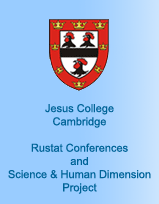

Rustat Report on Blockchain published
The report from the September 2016 Rustat Conference on Blockchain - Beyond Bitcoin is now published on the Rustat website.
Technology and AI Focus for Rustat Conferences in 2016
Machine Learning, Artificial Intelligence, the Blockchain and the Future of Work - these vital issues of today to feature in Rustat Conferences in 2016.
Rustat Conference Report on the UK North South Divide published
A diverse range of perspectives, opinions and policy suggestions appear in this new report from the UK North South Divide Rustat Conference - now available.
Big Data Analytics - Conference Report Published
The Rustat Conference on Big Data was held in collaboration with Cambridge Big Data Strategic Initiative on 30 September 2015 - report is now published.
Inequality - Rustat Conference Report
The proceedings of the March 2015 Inequality conference have been published on the Rustat website.
Transport & Energy Rustat Conference Report - November 2014
KPMG, Laing O'Rourke, McLaren, BP, Shell, HS2 and others tackled the most pressing UK transport and related energy questions.
Health Innovation: A Cambridge Success Story
The Rustat Conference on the development of the drug Campath-1H, entitled "Health Innovation: A Cambridge Success Story", took place at Jesus College on 29 January 2013. A report will be published shortly on the Rusat Conferences website.
Managing Organisational Change in the Economic Crisis
The Rustat Conference on Managing Organisational Change was held at Jesus College on 4 December 2012. The conference report is now available to download here.
The Future of Research-Intensive Universities
The sixth Rustat Conference discussed the future of research-intensive universities and was jointly hosted by the Vice-Chancellor of the University of Cambridge, Professor Sir Leszek Borysiewicz, and Professor Ian White, Master of Jesus College
Rustat Conference on UK Manufacturing
The fifth Rustat Conference was held at Jesus College, Cambridge, on 24 November 2011. Proceedings focused upon the challenges and opportunities facing the UK manufacturing sector. Chaired by Professor Ian White FREng, the conference featured contributions from leading figures from industry, government and academia.
Science - The Next Generation
Science and Human Dimension 11 May 2011
11 May 2011
Jesus College, Cambridge
Background and Overview
Lord Drayson, UK science minister, commissioned a report, Science and the Media – Securing the Future written by a group chaired by Fiona Fox, director of the Science Media Centre. The report drew on research conducted by Cardiff University journalism department. While being relatively optimistic, the findings warned of serious threats to the quality and independence of science reporting due to wider crises in the media. Major economic and institutional changes in the traditional print and broadcast media, not least circulation falls and the pressures of ratings, have added to the constraints under which journalists work at the best of times.
The results are heavier workloads, and shorter deadlines, leading to less scope to investigate and check facts; greater reliance on limited pools of news sources, a tendency to sensationalize and trivialize. Staff cuts, reductions in editorial space, a squeeze on editorial budgets have meant less opportunities for free-lancers and staff appointments. The new media appears to offer unprecedented scope for aspiring science journalists to be published, but does this make for reliable journalism or constitute a real potential for making a living?
Nevertheless, the impact of the science media (including medicine, technology) on society, the economy, and the environment, grows apace. High quality, responsible science reporting is crucial both to public understanding of a range of issues as well as the decisions of government.
Over the past two decades the Science and Human Dimension Project at Jesus College, Cambridge, has convened conferences as a contribution to public understanding of science. Our aim has been to enhance the quality of the science media and to encourage scientists to participate in outreach to the public.
This one-day meeting on Wednesday May 11, 2011 (in association with City University Journalism School and BlueSci) brought together a group of young scientists to discuss the problems and constraints, the scope and potential, of careers in science journalism at a time of rapid media change and challenge. We took advice from Lord Martin Rees, Professor John Naughton, Roger Highfield, Peter Tallack, Lou Woodley, Philip Ball, and Clive Cookson. The structure of the meeting was designed to promote an exchange of viewpoints and a sharing of experiences. Each segment was be introduced briefly by two seasoned practitioners: followed by open-floor discussion. The proceedings will be available for dissemination to schools of journalism and the wider public.
Agenda
Registration: 9.00-9.45am Prioress’s Room, Cloister Court, Jesus College
Introduction: 9.45am Upper Hall, Jesus College
Session 1: 10.00-10.50am: Prof John Naughton (OU and The Observer) and Lou Woodley (Nature)
Science Journalism in an Era of New Media: Opportunities and Challenges
Coffee
Session 2: 11.30-12.30am: David Adam (Nature)
Popular Interest in Science: the Next “Big Stories”
Lunch
Session 3: 1.45-2.45pm: Andrew Brown (The Guardian), Dennis Alexander (Faraday Institute)
Impact of Science Journalism on Culture and Society
Session 4: 2.45-3.45pm: Simon Singh (author), Adam Wishart (author and film maker)
Ethics and Science Media: Constraints and Dilemmas, Accuracy and Honesty
Break
Session 5: 4.15-5.15pm: Peter Tallack (The Science Factory), Christopher Potter (author and publisher)
Prospects For Science Books: Markets, E-publishing, Academic versus Non-Academic
________________________________
